The can stack motors market is projected to grow from USD 572.1 million in 2025 to USD 996.0 million by 2035. The can stack motors market is positioned for sustained expansion as precision motion control becomes increasingly important across medical equipment manufacturing, aerospace component assembly, laboratory automation, and compact industrial drive systems. Can stack motors are valued for their ability to deliver controlled linear and rotary motion in compact footprints, enabling high accuracy performance in devices such as infusion pumps, diagnostic instruments, positioning stages, aerospace mechanisms, and small-scale robotic systems. Their cost efficiency, mechanical stability, and versatility in low-to-medium torque applications make them a preferred choice for OEMs seeking reliable actuator solutions without the complexity or cost of larger motor assemblies.
Between 2025 and 2030, the market is expected to grow from USD 572.1 million to approximately USD 754.9 million, contributing USD 182.8 million, or 43 percent, of the total projected growth. This phase reflects accelerated implementation of compact and integrated motor systems that support miniaturization trends in medical devices, consumer electronics, and portable automation equipment. Advances in coil design, magnetic materials, and motor driver integration are enhancing power density and control responsiveness, while improved manufacturing precision is enabling tighter performance tolerances. As automation expands into more compact and mobile platforms, demand for can stack motors with high reliability and energy-efficient operation is expected to strengthen further.
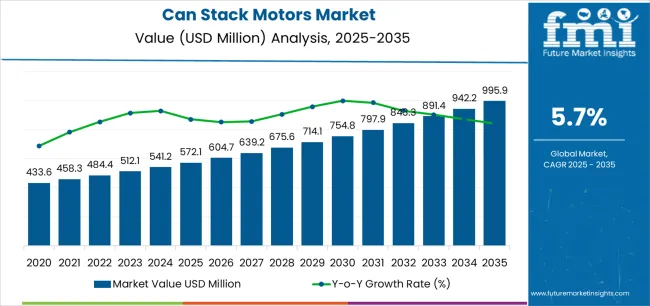
The latter half (2030-2035) will witness continued growth from USD 754.9 million to USD 996.0 million, representing an addition of USD 241.1 million or 57% of the decade's expansion. This period will be defined by mass market penetration of miniaturized motor technologies, integration with comprehensive automation platforms, and seamless compatibility with existing robotics infrastructure. The market trajectory signals fundamental shifts in how automation facilities approach motion control and system integration, with participants positioned to benefit from growing demand across multiple motor designs and application segments.
| Period | Primary Revenue Buckets | Share | Notes |
|---|---|---|---|
| Today | New motor sales (stepper, disc magnet) | 54% | Capex-led, automation-driven purchases |
| Custom motor configurations | 24% | Application-specific designs, performance optimization | |
| Service and maintenance | 14% | Repair services, preventive maintenance | |
| Control systems and drives | 8% | Motor controllers, driver electronics | |
| Future (3-5 yrs) | Integrated motor systems | 48-52% | Smart motors, embedded controls |
| Custom engineering services | 22-26% | Application design, motion profiling | |
| Digital control solutions | 16-20% | IoT-enabled drives, predictive maintenance | |
| Service subscriptions | 10-14% | Performance guarantees, uptime management | |
| Technical consulting | 6-8% | System integration, application optimization | |
| Data services (performance analytics) | 4-6% | Motion analysis for automation users |
| Metric | Value |
|---|---|
| Market Value (2025) | USD 572.1 million |
| Market Forecast (2035) | USD 996.0 million |
| Growth Rate | 5.7% CAGR |
| Leading Technology | Linear Stepper Motors |
| Primary Application | Medical Devices Segment |
The market demonstrates strong fundamentals with linear stepper motors capturing a dominant share through advanced precision features and medical device optimization. Medical device applications drive primary demand, supported by increasing surgical automation and diagnostic equipment requirements. Geographic expansion remains concentrated in developed markets with established medical technology infrastructure, while emerging economies show accelerating adoption rates driven by healthcare manufacturing initiatives and rising quality standards.
Primary Classification: The market segments by motor design into linear stepper motors, disc magnet motors, and others, representing the evolution from basic motion devices to sophisticated drive solutions for comprehensive automation optimization.
Secondary Classification: Application segmentation divides the market into medical devices, aerospace, semiconductor equipment, robotics, and others sectors, reflecting distinct requirements for precision control, environmental resistance, and performance standards.
Regional Classification: Geographic distribution covers North America, Latin America, Western Europe, Eastern Europe, East Asia, South Asia Pacific, and Middle East & Africa, with developed markets leading adoption while emerging economies show accelerating growth patterns driven by automation expansion programs.
The segmentation structure reveals technology progression from standard motor devices toward sophisticated motion systems with enhanced precision and control capabilities, while application diversity spans from medical equipment to aerospace systems requiring advanced motion control solutions.

Market Position: Linear Stepper Motors command the leading position in the can stack motors market with 56% market share through advanced motion features, including superior positioning accuracy, operational precision, and medical device optimization that enable automation facilities to achieve optimal motion consistency across diverse medical and industrial environments.
Value Drivers: The segment benefits from medical device manufacturer preference for reliable motor systems that provide consistent positioning performance, excellent repeatability, and operational efficiency optimization without requiring significant system modifications. Advanced design features enable micro-stepping capability, smooth motion control, and integration with existing automation equipment, where precision performance and reliability represent critical application requirements.
Competitive Advantages: Linear Stepper Motors differentiate through proven positioning accuracy, consistent motion characteristics, and integration with automated control systems that enhance system effectiveness while maintaining optimal precision standards suitable for diverse medical and industrial applications.
Key market characteristics:
Disc Magnet Motors maintain a 32% market position in the can stack motors market due to their high power density properties and compact design advantages. These motors appeal to applications requiring high torque with minimal space for aerospace and semiconductor applications. Market growth is driven by miniaturization trends, emphasizing reliable motion solutions and power efficiency through optimized magnetic designs.
Other motor configurations account for 12% market share through specialized requirements in custom applications, hybrid designs, and application-specific solutions. These applications demand unique motor characteristics capable of meeting specific performance parameters while providing effective motion control and operational flexibility.
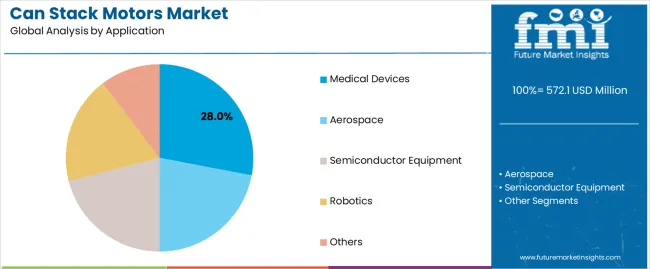
Market Context: Medical devices applications exhibit the highest growth rate in the can stack motors market, holding a 28% share. This growth is driven by the widespread adoption of surgical automation systems and a growing focus on diagnostic equipment precision, operational reliability, and healthcare quality applications, all of which aim to maximize patient outcomes while maintaining performance standards.
Appeal Factors: Medical device manufacturers prioritize motor reliability, positioning accuracy, and integration with existing equipment infrastructure that enables coordinated motion control across multiple device functions. The segment benefits from substantial healthcare investment and medical technology modernization programs that emphasize the acquisition of precision motors for device optimization and performance efficiency applications.
Growth Drivers: Surgical robotics programs incorporate can stack motors as standard components for motion operations, while diagnostic equipment growth increases demand for precision capabilities that comply with medical standards and minimize positioning errors.
Market Challenges: Varying device specifications and sterilization compatibility may limit motor standardization across different manufacturers or application scenarios.
Application dynamics include:
Aerospace applications capture 22 % share through specialized requirements in flight control systems, satellite mechanisms, and actuation devices. These facilities demand high-reliability motors capable of operating with extreme environments while providing effective motion control and operational durability capabilities.
Semiconductor Equipment applications account for 20% share, including wafer handling, inspection systems, and manufacturing equipment requiring precision positioning for production optimization and quality control.
Robotics applications demonstrate a strong market presence, capturing 18% of the market share. This includes collaborative robots, industrial automation, and assembly systems, all of which require compact motors for motion control and system integration.
| Category | Factor | Impact | Why It Matters |
|---|---|---|---|
| Driver | Medical device automation and surgical robotics growth (minimally invasive surgery) | ★★★★★ | Requires precision motors with positioning accuracy and reliability for critical medical applications across production installations. |
| Driver | Miniaturization trends and space-constrained applications (portable devices) | ★★★★★ | Turns compact motor designs from optional to mandatory; vendors providing high power density and custom engineering gain competitive advantage. |
| Driver | Industry 4.0 and smart manufacturing adoption (connected automation) | ★★★★☆ | Manufacturers need intelligent motion control; demand for IoT-enabled motors with diagnostic capabilities expanding addressable market. |
| Restraint | High development costs and customization complexity | ★★★★☆ | Small manufacturers defer purchases; increases engineering investment and slows custom motor adoption in cost-sensitive markets. |
| Restraint | Competition from alternative motor technologies | ★★★☆☆ | Brushless DC motors and linear motors provide alternatives, limiting market penetration in certain applications. |
| Trend | Integration of sensors and feedback systems | ★★★★★ | Embedded encoders, force sensing, and closed-loop control transform performance; intelligence becomes core value proposition. |
| Trend | Customization and application-specific designs | ★★★★☆ | Tailored motor solutions for unique requirements; rapid prototyping and engineering services drive competition toward specialized offerings. |
The can stack motors market demonstrates varied regional dynamics with Growth Leaders including China (7.7% growth rate) and India (7.1% growth rate) driving expansion through automation manufacturing initiatives and production capacity development. Steady Performers encompass Germany (6.6% growth rate), United States (5.4% growth rate), and developed regions, benefiting from established automation industries and advanced motion control adoption. Emerging Markets feature Brazil (6.0% growth rate) and developing regions, where automation initiatives and manufacturing modernization support consistent growth patterns.
Regional synthesis reveals East Asian markets leading adoption through automation expansion and manufacturing development, while North American countries maintain steady expansion supported by medical device advancement and precision automation requirements. European markets show moderate growth driven by aerospace applications and quality integration trends.

| Region/Country | 2025-2035 Growth | How to win | What to watch out |
|---|---|---|---|
| China | 7.7% | Lead with cost-effective solutions | Quality consistency; IP protection |
| India | 7.1% | Focus on medical device partnerships | Infrastructure gaps; technical expertise |
| Germany | 6.6% | Offer precision engineering | Certification complexity; validation costs |
| USA | 5.4% | Provide custom design services | FDA compliance; sourcing concerns |
| Brazil | 6.0% | Value-oriented products | Import duties; economic volatility |
| UK | 4.8% | Push medical applications | Regulatory changes; market consolidation |
| Japan | 4.3% | Focus on precision robotics | Conservative adoption; high standards |

China establishes fastest market growth through aggressive automation manufacturing programs and comprehensive robotics production development, integrating advanced can stack motors as standard components in medical device assembly and semiconductor equipment installations. The country's 7.7% growth rate reflects government initiatives promoting automation technology and domestic motion control capabilities that mandate the use of precision motors in medical and industrial facilities. Growth concentrates in major manufacturing hubs, including Shenzhen, Shanghai, and Suzhou, where automation technology development showcases integrated motor systems that appeal to manufacturers seeking advanced motion capabilities and precision applications.
Chinese manufacturers are developing cost-effective can stack motor solutions that combine domestic production advantages with advanced motion features, including precision positioning and compact designs. Distribution channels through automation equipment suppliers and medical device service distributors expand market access, while government support for advanced manufacturing supports adoption across diverse medical and robotics segments.
Strategic Market Indicators:
In Bangalore, Mumbai, and Pune, medical device facilities and automation manufacturing plants are implementing advanced can stack motors as standard components for motion control and precision applications, driven by increasing government healthcare investment and manufacturing modernization programs that emphasize the importance of automation capabilities. The market holds a 7.1% growth rate, supported by government automation initiatives and manufacturing infrastructure development programs that promote advanced motors for medical and industrial facilities. Indian operators are adopting can stack motors that provide consistent motion performance and quality compliance features, particularly appealing in urban regions where precision and reliability standards represent critical operational requirements.
Market expansion benefits from growing medical device manufacturing capabilities and international technology partnerships that enable domestic production of advanced motor systems for healthcare applications. Technology adoption follows patterns established in motion control equipment, where precision and performance drive procurement decisions and automation deployment.
Market Intelligence Brief:
Germany establishes precision engineering leadership through comprehensive automation programs and advanced medical technology development, integrating can stack motors across medical device and aerospace applications. The country's 6.6% growth rate reflects established medical device industry relationships and mature motion control technology adoption that supports widespread use of precision motors in surgical and industrial facilities. Growth concentrates in major technology centers, including Bavaria, Baden-Wurttemberg, and Hesse, where automation technology showcases mature motor deployment that appeals to manufacturers seeking proven precision capabilities and reliability applications.
German motor providers leverage established distribution networks and comprehensive engineering support capabilities, including medical device qualification programs and custom design support that create customer relationships and operational advantages. The market benefits from mature medical standards and aerospace requirements that mandate precision motor use while supporting technology advancement and motion optimization.
Market Intelligence Brief:
United States establishes medical device leadership through comprehensive healthcare programs and advanced surgical automation infrastructure development, integrating can stack motors across medical device and robotics applications. The country's 5.4% growth rate reflects established medical technology industry relationships and mature automation technology adoption that supports widespread use of precision motors in surgical and diagnostic facilities. Growth concentrates in major medical technology regions, including Massachusetts, California, and Minnesota, where medical device technology showcases mature motor deployment that appeals to manufacturers seeking proven motion capabilities and FDA compliance applications.
American motor providers leverage established distribution networks and comprehensive engineering support capabilities, including medical device validation programs and custom design support that create customer relationships and operational advantages. The market benefits from mature FDA standards and medical requirements that mandate precision motor use while supporting technology advancement and device optimization.
Market Intelligence Brief:
Brazil's market expansion benefits from diverse automation demand, including medical device development in Sao Paulo and Campinas, manufacturing facility upgrades, and government healthcare programs that increasingly incorporate precision motors for automation applications. The country maintains a 6.0% growth rate, driven by rising medical device manufacturing activity and increasing recognition of precision motor technology benefits, including accurate positioning and enhanced operational reliability.
Market dynamics focus on cost-effective motor solutions that balance advanced motion performance with affordability considerations important to Brazilian medical device manufacturers. Growing healthcare industrialization creates continued demand for modern motor systems in new facility infrastructure and manufacturing modernization projects.
Strategic Market Considerations:
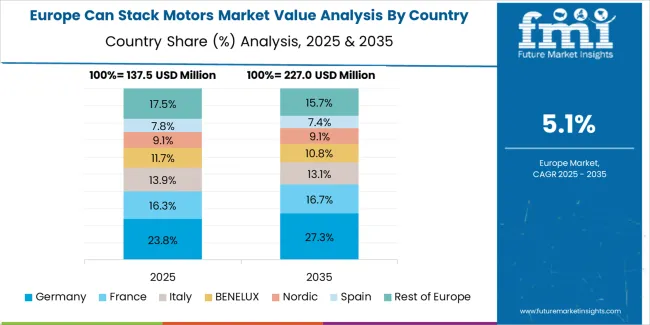
The can stack motors market in Europe is projected to grow from USD 208.1 million in 2025 to USD 330.3 million by 2035, registering a CAGR of 4.7% over the forecast period. Germany is expected to maintain its leadership position with a 37.8% market share in 2025, supported by its advanced medical device infrastructure and major precision engineering centers.
United Kingdom follows with a 21.6% share in 2025, driven by comprehensive medical technology programs and surgical robotics initiatives. France holds a 18.2% share through specialized aerospace applications and medical device requirements. Italy commands a 12.4% share, while Spain accounts for 10.0% in 2025. The rest of Europe region is anticipated to gain momentum, expanding its collective share from 5.8% to 6.6% by 2035, attributed to increasing motor adoption in Nordic countries and emerging medical device facilities implementing manufacturing modernization programs.

Japan's can stack motors market benefits from established robotics manufacturing excellence and comprehensive quality standards. The country maintains a 4.3% growth rate, supported by government initiatives promoting advanced automation and precision technology advancement. Major manufacturing centers in Tokyo, Nagoya, and Osaka showcase advanced motor deployment for robotics applications and semiconductor equipment. Japanese manufacturers prioritize motor precision and reliability, creating demand for premium systems with superior positioning accuracy and environmental stability. Distribution channels through established automation equipment networks enable broad market access across robotics and medical device segments.
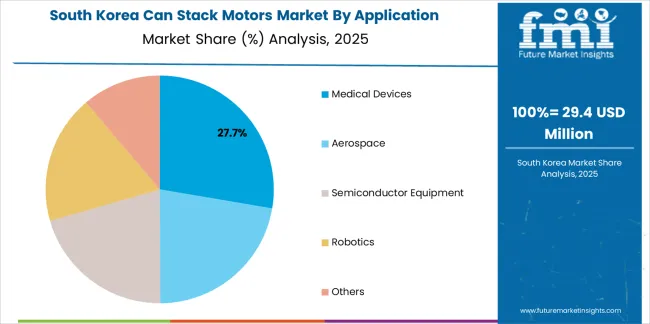
South Korea's market expansion reflects advanced semiconductor manufacturing infrastructure and comprehensive automation programs. The country demonstrates strong adoption of precision motors in semiconductor facilities across Gyeonggi, Seoul, and Chungcheong. Growth is driven by semiconductor production initiatives and increasing focus on automation quality standards. Korean manufacturing facilities emphasize compact motor solutions with precision positioning and clean room compatibility. Market development benefits from government semiconductor technology investment programs and established motion control manufacturing capabilities supporting domestic production of advanced can stack motor systems.
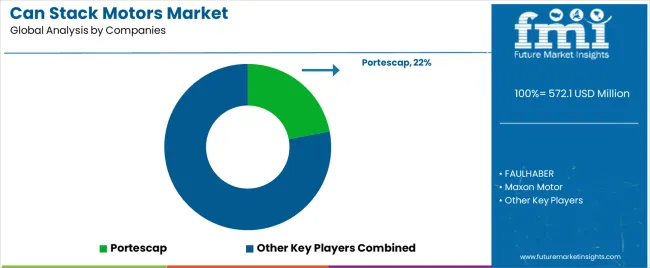
The can stack motors market maintains a moderately concentrated structure with 12-15 credible players, where the top 5-6 companies hold approximately 65-72% by revenue. Market leadership is maintained through engineering expertise networks, application support capabilities, and design innovation encompassing power density optimization, precision control, and thermal management. Competition centers on positioning accuracy, power efficiency, and integration with automation workflows including motion controllers and feedback systems.
Basic motor designs and standard configurations are commoditizing, shifting competitive advantage toward advanced features such as integrated sensors, custom winding patterns, and comprehensive engineering support services. Margin opportunities concentrate in custom motor design, application engineering, and integration into automation workflows with motion profiling and system optimization programs. Leading manufacturers differentiate through extensive testing data supporting medical device and aerospace applications, comprehensive technical documentation for design engineers, and responsive custom engineering reducing development timelines.
The competitive landscape features global precision motor manufacturers leveraging broad distribution networks and established medical device relationships, specialized can stack motor companies focusing on design innovation and application expertise, regional motion control suppliers providing localized support and competitive pricing, and emerging smart motor providers introducing integrated electronics and IoT capabilities. Strategic partnerships between motor manufacturers and automation system integrators are increasing, enabling complete motion solutions and expanding addressable markets beyond traditional medical applications into robotics and semiconductor equipment sectors.
Market dynamics favor participants with proven reliability validation, comprehensive engineering support networks, and ability to meet medical device grade quality requirements. Design refresh cycles accelerate as smart features and miniaturization become standard expectations, while medical device certification and aerospace qualification create barriers to entry protecting established players. Pricing pressure emerges in commodity automation applications, while premium positioning remains viable for manufacturers offering comprehensive engineering solutions with demonstrated precision performance and integration capabilities supporting advanced medical device manufacturing initiatives.
| Item | Value |
|---|---|
| Quantitative Units | USD 572.1 million |
| Motor Design | Linear Stepper Motors, Disc Magnet Motors, Others |
| Application | Medical Devices, Aerospace, Semiconductor Equipment, Robotics, Others |
| Regions Covered | North America, Latin America, Western Europe, Eastern Europe, East Asia, South Asia Pacific, Middle East & Africa |
| Countries Covered | United States, China, Germany, India, United Kingdom, Japan, Brazil, France, South Korea, Switzerland, and 20+ additional countries |
| Key Companies Profiled | Portescap, FAULHABER, Maxon Motor, Ametek, Allient, Moons' Industries, Constar Motion, Topband Motor |
| Additional Attributes | Dollar sales by motor design and application categories, regional adoption trends across East Asia, South Asia Pacific, and North America, competitive landscape with precision motor manufacturers and automation equipment suppliers, engineer preferences for positioning accuracy and power density, integration with motion control platforms and feedback systems, innovations in compact design and sensor integration, and development of smart motor solutions with enhanced precision performance and automation optimization capabilities. |
The global can stack motors market is estimated to be valued at USD 572.1 million in 2025.
The market size for the can stack motors market is projected to reach USD 995.9 million by 2035.
The can stack motors market is expected to grow at a 5.7% CAGR between 2025 and 2035.
The key product types in can stack motors market are linear stepper motors , disc magnet motors and others.
In terms of application, medical devices segment to command 28.0% share in the can stack motors market in 2025.






Full Research Suite comprises of:
Market outlook & trends analysis
Interviews & case studies
Strategic recommendations
Vendor profiles & capabilities analysis
5-year forecasts
8 regions and 60+ country-level data splits
Market segment data splits
12 months of continuous data updates
DELIVERED AS:
PDF EXCEL ONLINE
Can Stack Stepper Motors Market Forecast and Outlook 2025 to 2035
Cancer Registry Software Market Size and Share Forecast Outlook 2025 to 2035
Canine Arthritis Treatment Market Forecast and Outlook 2025 to 2035
Canned Wet Cat Food Market Size and Share Forecast Outlook 2025 to 2035
Canned Food Packaging Market Size and Share Forecast Outlook 2025 to 2035
Canada Compact Wheel Loader Industry Analysis Size and Share Forecast Outlook 2025 to 2035
Cancer Biological Therapy Market Size and Share Forecast Outlook 2025 to 2035
Canned Wine Market Size and Share Forecast Outlook 2025 to 2035
Canned Pet Food Market Analysis - Size and Share Forecast Outlook 2025 to 2035
Canada Straws Market Size and Share Forecast Outlook 2025 to 2035
Canthaxanthin Market Size and Share Forecast Outlook 2025 to 2035
Canned Food Packaging Industry Analysis in the United Kingdom Size and Share Forecast Outlook 2025 to 2035
Canada Executive Education Program Market Size and Share Forecast Outlook 2025 to 2035
Can Packaging Market Size and Share Forecast Outlook 2025 to 2035
Candidiasis Therapeutics Market Size and Share Forecast Outlook 2025 to 2035
Canada Eyeshadow Stick & Blush Stick Market Size and Share Forecast Outlook 2025 to 2035
Cancer Diagnostics Market Analysis - Size, Share and Forecast 2025 to 2035
Cannabidiol CBD Pet Market Size and Share Forecast Outlook 2025 to 2035
Can Lid Market Size and Share Forecast Outlook 2025 to 2035
Cannabis Packaging Market Size and Share Forecast Outlook 2025 to 2035

Thank you!
You will receive an email from our Business Development Manager. Please be sure to check your SPAM/JUNK folder too.
Chat With
MaRIA